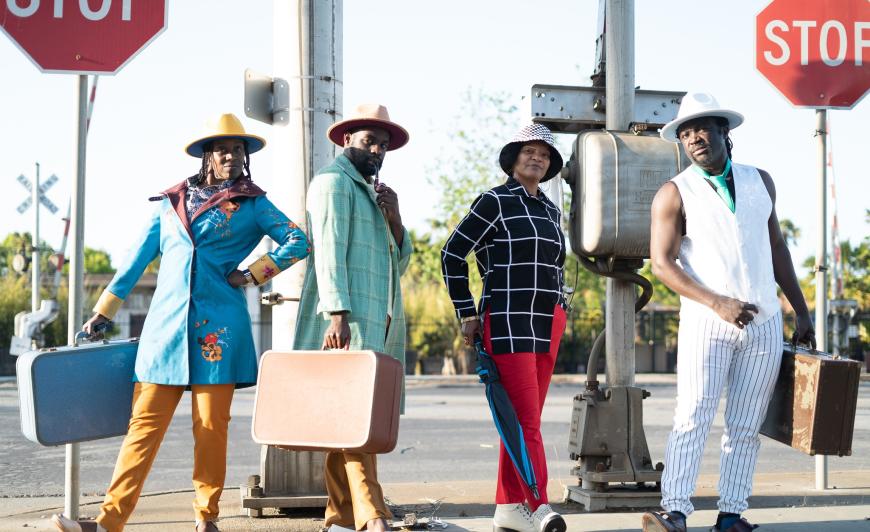
It’s Sunday just after 6 p.m. on a glorious day in the Bay Area. The outside temperature in the city of Richmond is still 75 degrees, and Chanel “Byb” Bibene is in a tank top, long pants, and bare feet as he greets his dancers at a rehearsal for the July 1–2 world premiere of Religion Kitendi: Dress Code. As the dancers enter the space, a warehouse-looking structure minutes from Interstate 580, they pass furniture topped with postcards for the premieres, next to a circular sign that says, in all capital letters, “SPEED LIMIT.” The numbers that should be at the bottom of that “SPEED LIMIT” sign are all cut out — a giant, poignant metaphor for what Bibene and his dancers do in rehearsal, and what they’ll also do at their premiere performances in San Francisco.
The dancing will be frenetic. And fun. And infectious. Limits? Forget it. These performances, complete with scintillating music that’s both live and recorded, will mirror a public spectacle done by sapeurs who live in Bibene’s native country, the Republic of the Congo. For all intents and purposes, sapeurs practice a sport of sartorial reinvention. In Congo, some practitioners will spend a lifetime of savings on shoes or suits that dazzle with color and cultural cachet, giving these devoted practitioners an exalted way to be in the world and, at competitions with other sapeurs, to playfully tell their fellow fashion-striving practitioners: You can’t compete with my style, my movements, or my braggadocio.
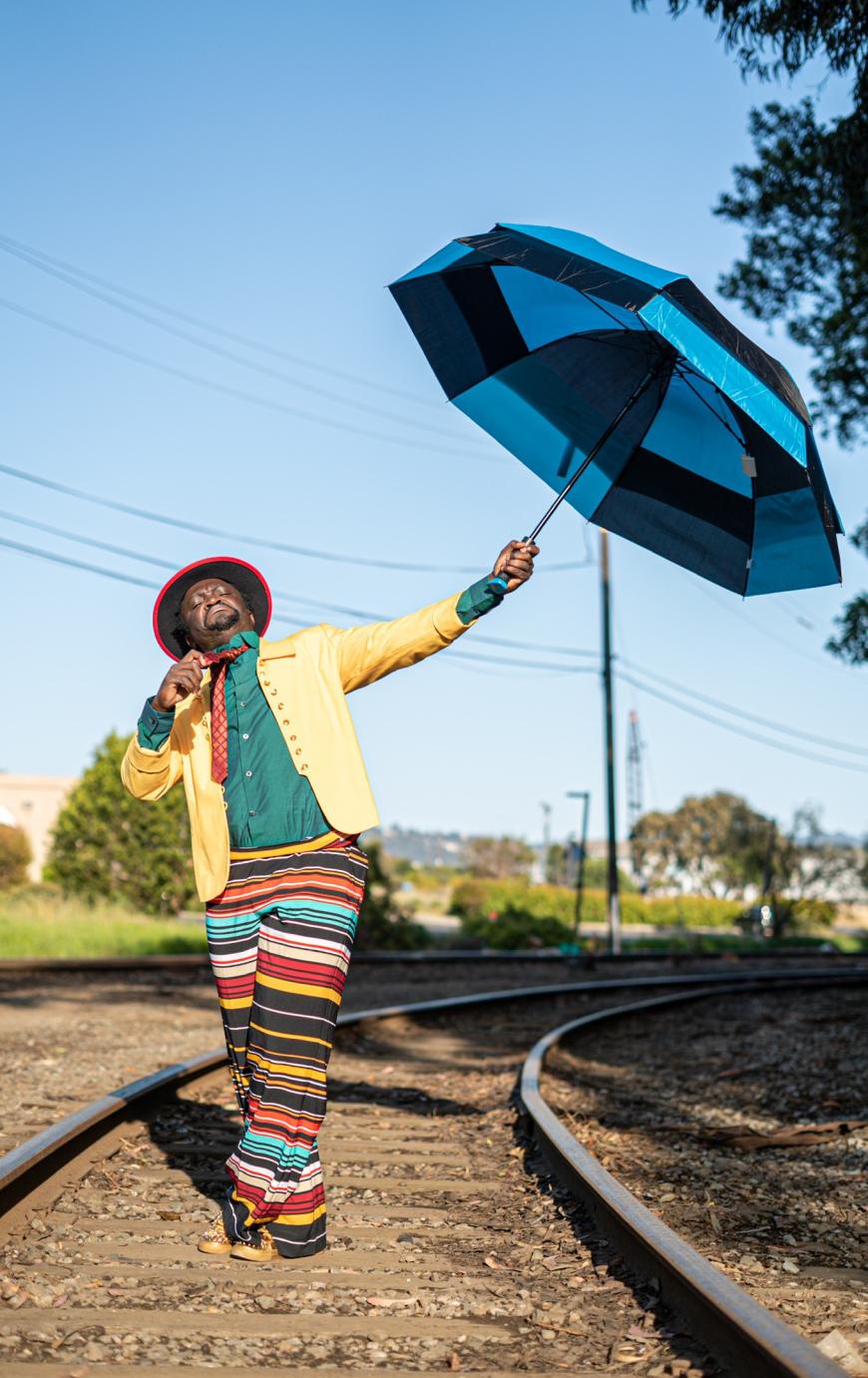
The label that describes the show-offs is a derivation of the French name for “Société des ambianceurs et des personnes élégantes.” In English, it’s the “Society of Tastemakers and Elegant People.” If it sounds like an elite group of self-anointed dandies — well, it is, according to Bibene. In 2020, the BBC did a big online profile of sapeurs who were as young as 5. “Congo’s sapeurs pass their style on to a new generation,” the headline blared, five years after the BBC did a video report on sapeurs in the Republic of the Congo and in the Democratic Republic of the Congo, the country that neighbors Bibene’s native country and that — especially in their neighboring capitals — shares much of the same music, dance, and other forms of expression. That expression includes the French language, which is a vestige of French colonial rule. In fact, French and France helped give birth to both the phrase sapeurs and to its practice in Central Africa.
Kitendi means “clothing” in Lingala, a language that more than 10 million people speak in Central Africa, so the title of Bibene’s event at the San Francisco International Arts Festival couches the sapeurs’ practice in religious terms, which seems appropriate.
At ODC Theater, Bibene’s Kiandanda Dance Theater will present the sapeurs in all their complicated pageantry, which means briefly alluding to France’s colonial history and the economic dissonance that prompts many sapeurs to forgo future savings for the satisfaction of showing off items that can cost tens of thousands of dollars. The July 1–2 performances will tamp down the socioeconomic threads of the practice for the more show-off side that inspires audiences in Congo’s capital to line up for the spectacle. The bonus: At ODC, audiences will see not just dancers but Manolo Davila, a standout San Francisco musician who will play drums and guitar and — just as he did in that Sunday rehearsal — perform with the dancers by serving drinks and participating in the dazzling movement that audiences will inhabit.
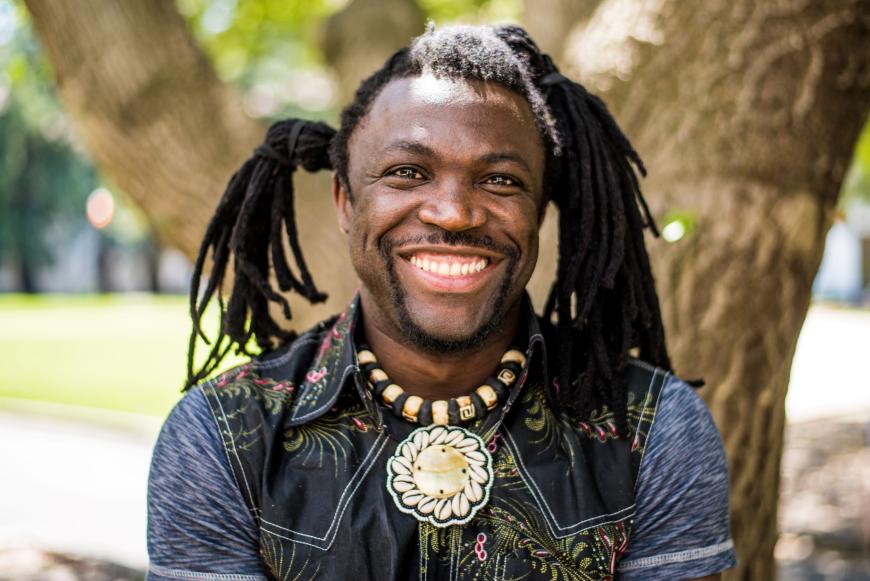
“We are looking at Congolese dance culture but also the musical culture,” Bibene tells San Francisco Classical Voice. “This comes from a place of joy. ... Many of the projects that I’ve previously done were heavily political, and this one touches on colonization since fashion [in the Republic of the Congo] is inspired by European fashion and is inspiring Congolese people in the way they dress. However, we want to show this movement in which Congolese people use fashion to be happy— and to face life, and the challenges of life, and to overcome all sorts of difficulties of looking good and feeling good in the shoes and clothes that they wear.
“When [the sapeurs] dress up, they go to bars,” Bibene adds. “They’re also on the streets and doing dance and music that is trending.”
Bibene founded his dance company in the Congo in 2008, but it’s now based in San Francisco. And Bibene and his company have thrived in the Bay Area, where they have put on performances at multiple venues and from where they have gone abroad to perform — including to France and the Republic of the Congo. At Sunday’s rehearsal, Bibene worked with Davila and three dancers, who led and followed Bibene around the venue as light poured in from two windows facing San Francisco.
“Do you want me to do a Michael Jordan jump?” dancer Shawn Hawkins asked Bibene, referencing basketball’s most notable player of the 20th century, whose dunks would electrify anyone in attendance — and whose dunks still entertain and inspire millions of viewers on YouTube.
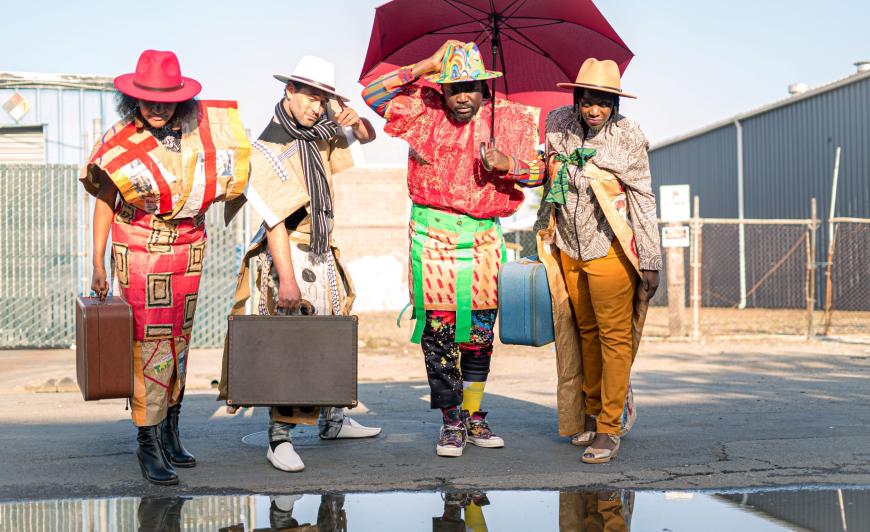
Bibene moved closer to Hawkins, adjusted Hawkins’s positioning a bit, and then said, “Take it from the top” — at which point Hawkins and Bibene swayed their hips back and forth and continued a dance that, on July 1 and 2, will have Hawkins, Bibene, and the other dancers stroll here and there, shake their feet as they show off their shoes, rush to outfits on rolling closets, and grab suitcases on the stage that represent the clothing they need to compete with each other. They’ll also do what sapeurs do in Central Africa: Compete for the spotlight of attention. One by one, each dancer moves the central dancer aside — with verbiage that overwhelms the competition and with nudging that speaks to the sports motif of the sapeurs’ public engagement.
With its light fixtures, high ceilings, and large amount of usable space, the Richmond rehearsal space looked like a Hollywood set. In 2014, millions of people got a glimpse of sapeurs through. of all things, a TV ad campaign for Guinness beer. The ad, which ran one minute and 39 seconds and is now on YouTube, has a deeply voiced African narrator who says the following as viewers see Congolese men in Brazzaville, the Republic of Congo’s capital, doing intensely manual labor like carrying ice and tree carvings on their shoulders: “In life, you can’t always choose what you do — but you can always choose who you are.” Then the ad shows Congolese men putting on nice shoes, grooming, and otherwise emerging as seemingly different people. “We are the sapeurs,” the voice says, as viewers see, yes, elegantly dressed men — in slow motion, even — walk around Brazzaville.
The ad also has the men showing off their sartorial wears inside a bar where people clap wildly for their sparkling kitendi. Says the ad’s narrator: “We say, ‘I am the master of my own fate.’” The ad then juxtaposes that scene with a bartender pouring Guinness beer. That ad helped spark the BBC to do its 2015 video report, which was headlined, “Meeting the most fashionable crowd in DRC,” and undoubtedly laid the groundwork for the BBC to do its follow-up report.
People who go to see the world premiere of Religion Kitendi: Dress Code won’t get any mention of that beer ad or the BBC’s reports. Religion Kitendi: Dress Code is Bibene’s creation, and he’s not trying to sell beer or to be a historian. Instead, he’s trying to educate people and remind them that forms of expression from the Republic of the Congo are worth paying attention to, beyond what people think they might know of the sapeurs, of Central Africa, of Congolese music, or of Congolese dance.
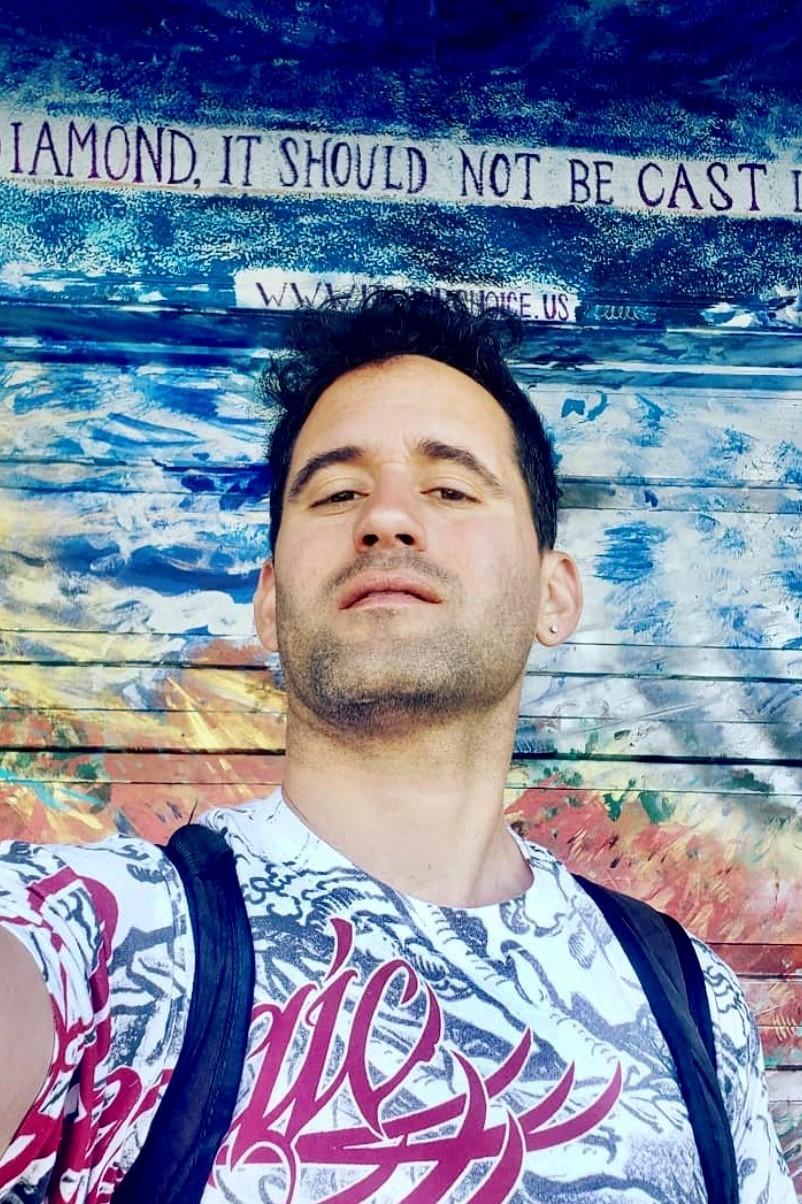
After taking in the Sunday rehearsal, I can say this: In Bibene’s movement and that of his dancers, and in Davila’s accompanying music, there is beauty and wonder and escape. Bibene wants people to see that beauty and wonder, because when they do, they might experience what I did that evening: Though I was sitting in a chair, I was moving my legs to the beats of the dance and of the indelible music that Davila played and to the songs that he and Bibene decided were entirely appropriate for the performances, including “Mamou II,” a song by the great African singer Franco that speaks about a troubling relationship on a precipice but does so in a way that is fun and full of joie de vivre. The lyrics of “Mamou II” have Franco crooning such French words as “je t’aime” — a phrase that can certainly be applied to Bibene’s love for dance, his love for orchestrating other dancers, and his love for his country and its culture. The emphasis on conveying joy over politics is partly a product of the pandemic.
“Since the past two to three years we’ve had the pandemic, and everything around us is stressful,” says Bibene, whose family in the Republic of the Congo had been internal refugees because of that country’s civil war in the 1990s. “Things have been difficult [during the pandemic]. I’ve lost a family member and my dad. So if I do a piece, I don’t want to tack on a heavy and emotionally charged topic. ... You take whatever was bad and make it positive, and you move on in life.”
That idea of making something positive and moving on is a very sapeur thing to do — another reason why the July 1–2 performances will be extra special for Bibene.
“I want to bring the audience something joyous — something that puts a smile on their faces and makes them happy. At the same time, they will discover this country. They will discover the Congo. They discover a part of the Congo that’s not based on negative images that the mainstream media like to portray about Africa. We can all discover that.”
Get tickets for Religion Kitendi: Dress Code on the San Francisco International Arts Festival’s website.


